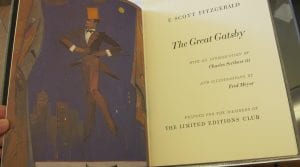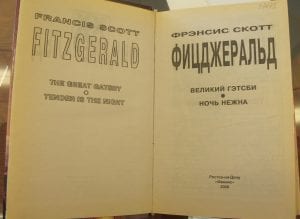#bannedbooksweek 2017: The Great Gatsby by F. Scott Fitzgerald
Banned Books Week, spanning September 24th to the 30th in 2017, is a time when libraries around the country celebrate the freedom to read and raise awareness of censorship. Since 1982 more than 11,300 books have been challenged, with this novel included in that number.


Published in 1925, The Great Gatsby by F. Scott Fitzgerald depicted the society result from the end of the Great War in the 20s. Fitzgerald uses the main character, Jay Gatsby, to take the reader through the roller coaster that was life in the 20s, and still today, consisting of poverty, wealth, love, pain, and death. Nick Carraway, the narrator from the midwest and Daisy Buchanan’s cousin, makes his way to New York where he becomes the neighbor of the mysterious Gatsby. With Nick’s help, Gatsby is reunited with the love of his life, Daisy, after five years apart. Gatsby and Daisy maintain an affair until her self-righteous husband, Tom, finds out. Gatsby tries with everything he’s got to win Daisy over, but she refuses to say that she never loved Tom. Turns out Tom is also in an affair, but this discovery has an entirely different outcome. Daisy, blinded with rage, runs Tom’s mistress, Myrtle, over with her car. When Tom tells Myrtle’s husband, George, that Gatsby was the one who did the job, he shoots Gatsby in his pool before killing himself as well. Daisy moves on with her “perfect “ life, pretending as though Gatsby never even existed, and Nick journeys back to the midwest in search for genuine people.

In 1987, the Baptist College in Charleston, SC challenged The Great Gatsby, arguing that Fitzgerald’s novel contains immoral “language and sex references” (Penn State). Although this was a heavy-handed opinion, there are many other interpretations of The Great Gatsby that provide reasons for why the novel should be made available and be taught in schools. Some even believe it is entirely necessary because of the way it can be used to teach valuable, historical lessons about the jazz age, mainly concerning prohibition. People were gluttonous, money was thrown around like candy, providing people with empty and temporary happiness in the form of superficial parties and booze. By Gatsby’s first-hand experience as a man who was only adored for his outrageous parties, his character along with the reader learne that money cannot buy you true friends that will be by your side to the end. None of Gatsby’s so-called friends even showed up to his funeral. The only people that attended were his father, the man with the owl eyes, and Nick. Despite the occasional inappropriate “language and sex references” (Penn State), this novel can be used to better understand the cultural context of the 1920s, rather than mundanely reading about it in a textbook. Such literary experiences can provide deeper meaning and understanding. A 1980 Limited Editions Club printing of this novel, featuring an introduction by Charles Scribner III and illustrations by Fred Meyer, can be found in Special Collections. Several other editions can be found on the 3rd floor of Linderman Library, including the Russian translation pictured here.

References
- https://sites.psu.edu/bannedbookscmlit130/2016/04/15/when-books-are-at-war-ft-the-great-gatsby/
- http://www.buffalo.edu/news/releases/2015/09/047.html